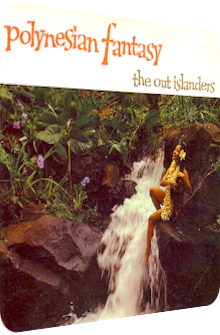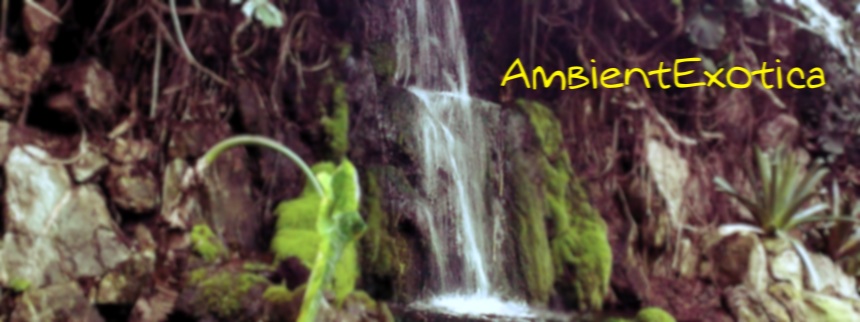
The Out Islanders
Polynesian Fantasy
1961
The Out Islanders is an Exotica supergroup formed by arranger and conductor Billy May in 1961, with their only album Polynesian Fantasy being recorded in February and released in the same year on Capitol Records. It features ten Exotica gold standards and two unique cuts envisioned by May. Polynesian Fantasy is a gorgeous album and one of the monoliths that can indeed be considered essential in the realms of the genre. Its large roster of talented players allows the conductor to realize multifaceted, densely layered but nonetheless utterly focused and non-gimmicky arrangements.
Among the people involved are Charlie Barnet as the lead saxophonist, Jimmy Rowles on the piano, drummer Irving "Irv" Cottler of Around The World In Percussion (1961) fame, Al Hendrickson on the guitar as well as the vocal talents of Marni Nixon and Loulie Jean Norman; however, there are also unmentioned harpists, ukulele players, flutists, mallet instrumentalists and brass players on board. The latter are especially important for the maintenance of the album’s intrinsic style. Somehow they deliver a true coup de main: neither are the brass backdrops fiery and Latinized, nor are they based on big band stereotypes, let alone jazzy convolutions. Not everything shines on the album, there are rare moments of schmaltziness, but these are – in their own peculiar way – totally fine, for the overwhelming majority of the material glows, is draped in warmth and usually resides in slower, only carefully beat-accentuated climes. Read more about one of the dreamiest albums ever, one whose signal term – Polynesian – does not translate to a bland Hapa Haole gallimaufry.
The first upwards floating, hyper-silky brass coils of Johnny Noble’s My Tane are among the most memorable launch phases of any Exotica album! The genteel loftiness unleashes towers of insouciance and joy. Lead saxophonist Charlie Barnet plays in a more ardent way, but the harp-accentuated alto flute backdrop and Al Hendrickson’s steel guitar lessen the energy and unchain soothing susurrations of paradise. Added vibraphone dots add a loungey luminosity to the scenery, with Irv Cottler’s laid-back bongo groove reassuring the listener incessantly that this corker is terrifically close to paradise. Seriously, My Tane has never sounded softer, it is less exuberantly exotic rather than keen on fathoming out the perfect blending of the various sub-genres. And it is hammock-compatible. What more does one wish for? Billy My’s own Little Island follows next, one of two unique tunes specifically written for the Out Islander’s album. It aurally paints a different scenery, namely that of an uplifting visit at the beach with wonky steel guitars that live up to the tradition of Hapa Haole. The rest, however, strays away from that genre’s reduction. Warbled flutes, a fast midtempo, rhythm ukuleles and a piano-marimba couple that reminds of – and precedes – Rex Kona & His Mandarins and their one-time affair Wild Orchids (1964) intertwine mellowly. The closing phase comprises a prolonged, eminently enchanting vibraphone droplet.
Alfred Newman‘s and Frank Loesser‘s The Moon Of Manakoora is a belter of a rendition and opens with a transcendental airflow of vibraphones, falsetto flutes and mellow brass breezes. Loulie Jean Norman sings the wordless lead melody and is accompanied by Charlie Barnet on the sax. Glitzy glockenspiels expand the moonlit theme, with only careful double bass accents, rainsticks and triangles plus a gently beaten conga being used as rhythmic devices. This tune truly lives up to the promise of the title. Its ambience is based on many instruments, but never feels overloaded or gimmicky. Despite the wealth of textures and the thickly wadded sound carpet, minimalism and solemnity reign. The Out Islanders’ version has everything it needs to sound chintzy… but it does not.
While the traditional China Sea opens the stylistic spectrum and moves to decidedly Far Eastern climes with Chinese gongs, pentatonic xylophone driblets, a sitar-like stringed instrument and a simply stunning piano-underlined brass interplay that is superbly soft, Jack Pitman’s smash hit from 1948 Beyond The Reef is a little letdown to my ears, as the magical diorama of mallet instruments and double bass billows is destroyed by the tenor saxophone playing the lead melody. Only the segues succeed with their benign alto flutes. Frank Loesser’s and Victor Schertzinger’s Sand In My Shoes, however, works well due to the typically jazzy upwards flowing and downwards falling rhythms, the piercing flute accents and the wooden xylophone blebs next to the lead sax. A swinging Jazz number at its core, it has that exotic vibe (and vibraphone) that lets it stand on the shoulders of archetypical big band numbers.
Side B opens with Buddy Bernier’s and Nat Simon’s Poinciana, a tastefully tropical cut of an eternal classic. Here, the balmy scents of the reeds and horns make all the difference in the world. Other versions out there often draw from cavalcades of colors and evoke a bustling energy. Not here, where everything is in a gentle fluxion. The oscillating flute melodies work well as the accompanying devices to Barnet’s saxophone, as do the marimba cascades. A paradisiac outing. And that adjective is also the key to Dimitri Tiomkin’s and Ned Washington’s Return To Paradise with its fissured percussion structure made of croaking guiros and abyssal kettle drums. The melody is transformed equally well. Polyphonous flutes, Marni Nixon’s chants, aeriform piano tercets as well as aqueous harps make this one of the very best versions out there, only beaten by Arthur Lyman’s take on Taboo 2 (1960) and the string-heavy Space-Age Tropicana on Axel Stordahl’s The Magic Islands Revisited (1962). Up next is Dick Manning’s and Irmgard Fardon Aluli’s Sea Breeze, a clinging and plinking piece of Hawaiiana with those quirkily elasticized steel guitar riffs and many horns. Too fast and upbeat, with its pieces not fitting together all too well, this one is the only tune that temporarily kills the endemic mood of the album.
The Out Islanders’ interpretation of Mercer Ellington’s Moon Mist tries to resurrect the titular fantasy. Written by the son of Duke Ellington, this piece features wordless vocals by Loulie Jean Norman and injects Irv Cottler’s easygoing bongo beat into a truly moony, saxophone-driven glitzscape supercharged with mellifluousness and gaseous breezes of verdure. An Ambient piece at its heart, Moon Mist is a revelation, especially so in its final eight seconds where rivers of mystical vibes create a glissando par excellence. Carl Sigman’s and Robert Maxwell’s Ebb Tide remains in that nightly aura as the Out Islanders graft a rhythm in 3/4 time onto the wind chime coppice. Flutes and horns make up the remaining parts of the arrangement. The saxophone is a bit over the top, but curiously enough, the composition as a whole is not, for it is less grandiloquent than many other interpretations of this classic.
The finale is a unique tune called Honorable Hong Kong Rock, written by Billy May. It resurrects – nomen est omen – the Asian timbre of China Sea and triples it. Pentatonic shards on the rhythm xylophone and guitar make this the most clichéd tune of the whole tracklist. Amid the staccato shrapnel of these devices, all too jocular brass melodies reside in the foreground, making an abominable hybrid out of this ditty, forcefully uniting the East with the West, but to no avail: this is too shifty a tune to be enjoyable. Only the echoey bass guitar flecks at the end hark back to the Rock portion of the title. At least Polynesian Fantasy ends with a dualistic bang, so I should not complain.
Polynesian Fantasy is a magnificent Exotica album with a wide array of moods and instruments. Similar to works such as The Surfmen’s The Sounds Of Exotic Island (1962) and the Kokee Band’s Exotica 1970 (1966), The Out Islander’s opus eximium is nurtured by the talent of all involved luminaries as well as the amount of players who make a dense thicket of reeds, mallet instruments and horns possible. That Billy May and his men do not misuse this overabundance but advect it in a concentrated, focused manner can only be applauded. The best examples in this regard are The Moon Of Manakoora and Moon Mist, and it is no accident that both titles about this crescent-ashen sphere are as keen on depicting a languorous ambience as on injecting washes of euphony. Each instrument is instantly recognizable and has a prominent place in the arrangement.
Whenever the sound feels delicately washed-out and positively blurry, it is due to the silky charm and care; the brass players come to mind, lead saxophonist Charlie Barnet being the only player who gyrates between various eclectic and electrifying states of his signature instrument. The concise infusions of Hapa Haole, i.e. steel guitars and ukuleles, round off the great work. It is not entirely clear what the big band wants their album to be, for this is no symphonic work, as those are known for aurally poeticizing the look onto their subject. The album title then gives the answer: this work is a truebred fantasy with fleeting visits to the Far East. Known melodies and favorites appear in limewashed form, sound fresh and soothing. It is wizardry! The Smith & Co label reissued the album in 2011 and made it available as a download version. Depending on the country you’re living in, it is either available on Amazon MP3 or iTunes, as well as in its original LP form. To me, it is an essential Exotica work of strikingly dreamy interpretations.
Further reading:
The comparably detailed Wikipedia article is a must-read if you want to know more about the album’s conception.
Exotica Review 273: The Out Islanders – Polynesian Fantasy (1961). Originally published on Oct. 19, 2013 at AmbientExotica.com.
